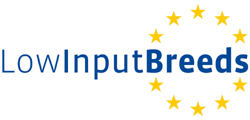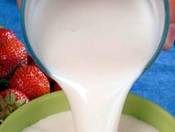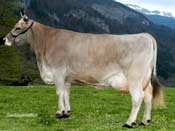Subproject 1: Dairy cows and cattle
Improving performance, animal health & welfare, environmental impact and product quality in organic and ‘low input’ dairy cow and beef cattle production systems
Responsible
The subproject
Work packages of subproject 1
- WP1.1 Development of WITHIN BREED selection systems to improve animal health, product quality and performance traits; comparing genome-wide and traditional quantitative-genetic selection
- WP1.2 Development of improved CROSS-BREEDING strategies to optimise the balance between ‘robustness’ and performance traits; comparing cross-breeds with pure-bred Holstein Friesian genotypes
- WP1.3 Design of optimised breeding and management systems for different MACRO-CLIMATIC REGIONS of Europe; model-based multi-criteria evaluation with respect to performance, animal health and welfare, product quality and environmental impact
Dairy cow and beef cattle production systems (subproject 1)
The aim of subproject 1 is to improve performance, animal health & welfare, environmental impact and product quality in organic and ‘low input’ dairy cow production systems. The work is organised in three work packages.
Main issues
The main issues addressed under subproject 1 are: Mastitis, fertility problems, milk quality and breeds/genotypes, milk composition, environmental impacts, lack of structured breeding programmes for organic and ‘low input’ systems.
Novel approaches, including genome-wide selection and cross-breeding, will be implemented and tested to assess the potential of these new technologies to solve those problems.
1. Mastitis remains a key challenge
Mastitis (and to a lesser extent foot diseases/lameness) remain the main health and animal welfare problems in organic and other ‘low input’ production systems.
Mastitis is a particular challenge and often causes significant economic losses for organic producers, because organic standards and/or certification bodies
- restrict the use of antibiotic treatments (e.g. prophylactic treatments for dry cows),
- encourage producers to use complementary remedies (e.g. homeopathy, nosodes) before resorting to veterinary medicine use and
- prescribe longer withdrawal periods after veterinary medicine use.
It has been estimated that more than 60% of veterinary antibiotic use in organic farming is for mastitis control. There are reports for lower levels of antibiotic use in organic and other ‘low input’ cattle production systems. However, other studies showed no significant differences in udder and foot health and antibiotic use between organic, ‘low input’ and high input production systems. The continuing high level of veterinary antibiotic use has resulted in consumers concerns about welfare standards, antibiotic residues in dairy products and the risk of ‘low input’ dairy systems contributing significantly to increasing problems with antibiotic resistant pathogens in human medicine.
2. Fertility problems as a result of metabolic disorders are a main issue
Fertility problems as a result of metabolic disorders are also a main issue in ‘low input’ and organic systems. They are often caused by imbalances between protein and energy supply in the total ration. Cows with high genetic potential for milk production may be at a greater risk of energy deficiencies in early lactation which could lead to metabolic disorders and fertility problems. In the organic sector
(a) the withdrawal of derogations on the use of non-organic concentrate feeds and
(b) the limited availability and increasing cost of organic concentrate feeds is expected to lead to reduction of concentrate and increase in forages in dairy rations. In organic farms with high yielding cows (e.g. Holstein Friesian genotypes) this may result in an increased incidence of metabolic disorders and fertility problems.
3. Higher milk quality in organic farming - also due to breeds/genotypes
Recent surveys have shown that milk from both (a) organic and (b) ‘low input,’ New Zealand-type, grazing-based dairy systems has significantly higher levels of nutritionally desirable fatty acids (e.g. polyunsaturated fatty acids, CLA and α-linoleic acid) and fat-soluble antioxidants/vitamins.
The differences in milk quality between high and ‘low input’ systems was associated with both the contrasting feeding regimes and breeds/genotypes being used.
Also a recent study in Belgium reported that heritabilities for fatty acids in milk fat ranged from 5 to 38% and that increases in milk fat content are not directly correlated with undesirable changes in fatty acid profiles, making future selection programmes focused on improving fatty acid composition in milk feasible.
4. Milk composition more variable in organic and 'low input' systems
However, the composition of milk from ‘low input’ systems was also shown to be more variable throughout the year and organic milk was reported to have higher somatic cell count levels. Also, the higher level of polyunsaturated fatty acids may result in a reduced oxidative stability and shelf life of milk. Nutritional quality is likely to become a key driver for increasing demand and maintaining price premiums for milk and dairy products from organic and ‘low input’ systems in the future, especially if recent reports linking human health benefits to organic milk consumption are confirmed.
5. Environmental impacts
Environmental impacts (greenhouse gas especially methane emissions, N-leaching, P-run-off) of ruminant production systems are also a major societal concern. Animal breeding and production system development must therefore attempt to provide a balance between animal health and welfare, product quality and environmental gains.
6. Lack of structured breeding programmes for organic and ‘low input’ systems
The development of more ‘robust’ genotypes via traditional and marker-assisted assisted breeding strategies is thought to be one of the most promising approaches to address the issues listed above. Genetic improvement is also thought to provide more sustainable/stable solutions compared to other measures (e.g. management strategies, veterinary treatments). However, there are currently no ‘within breed’ selection/breeding programmes targeting the needs (see above) of ‘low input’ and organic production systems.
Farmers switching from high input to organic and ‘low input’ New Zealand-type grazing based systems have started to cross their high yielding Holstein Friesian cows with smaller more robust breeds (e.g. Jerseys, Scandinavian Reds or Shorthorns) in some areas of Europe.
However, currently ongoing cross-breeding efforts are on an individual farm basis and there are no recording/analysis systems in place that would allow the relative success of different cross-breeding schemes to be compared, with respect to the robustness, productivity and milk quality parameters desired in the ‘low input’ dairy sectors.
Three work packages to address the issues
In order to address the different issues described above, the three main workpackages are focussing on:
- Development of WITHIN BREED selection systems to improve animal health, product quality and performance traits; comparing genome-wide and traditional quantitative-genetic selection
- Development of improved CROSS-BREEDING strategies to optimise the balance between ‘robustness’ and performance traits; comparing cross-breeds with pure-bred Holstein Friesian genotypes
- Design of optimised breeding and management systems for different MACRO-CLIMATIC REGIONS of Europe; model-based multi-criteria evaluation with respect to performance, animal health and welfare, product quality and envi-ronmental impact
 This website was archived on December 19, 2017 and is no longer updated.
This website was archived on December 19, 2017 and is no longer updated.




